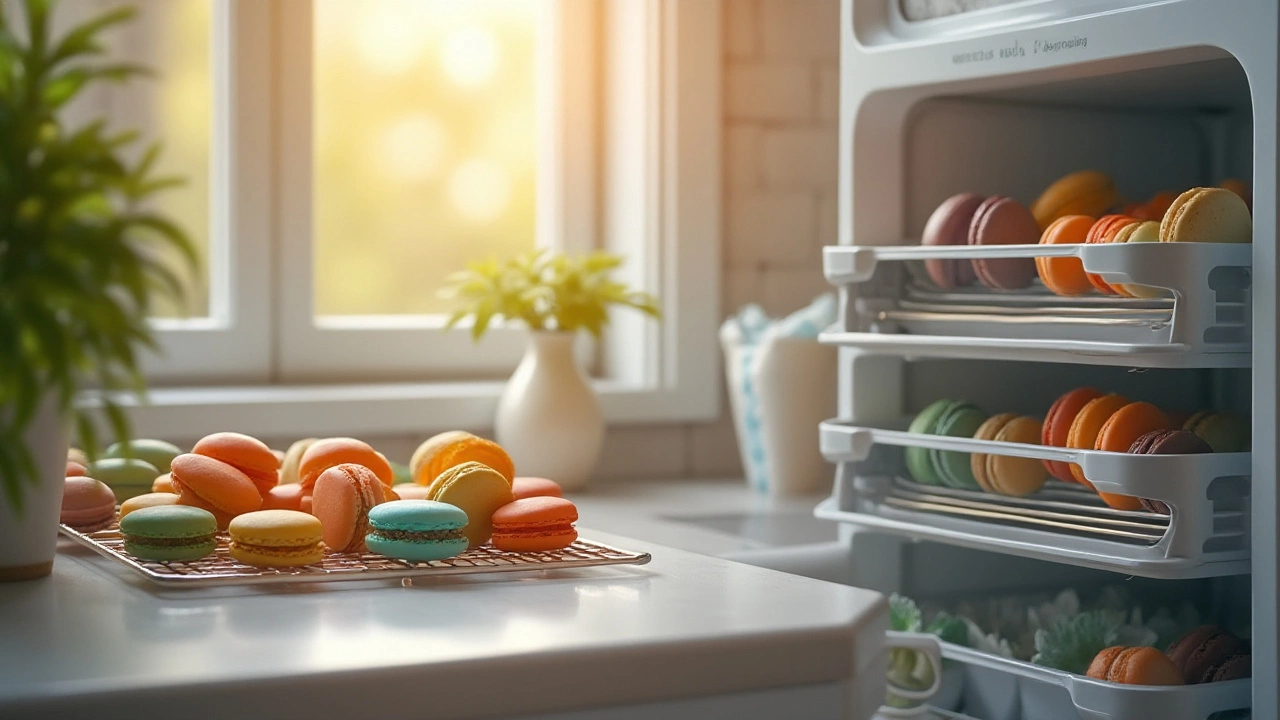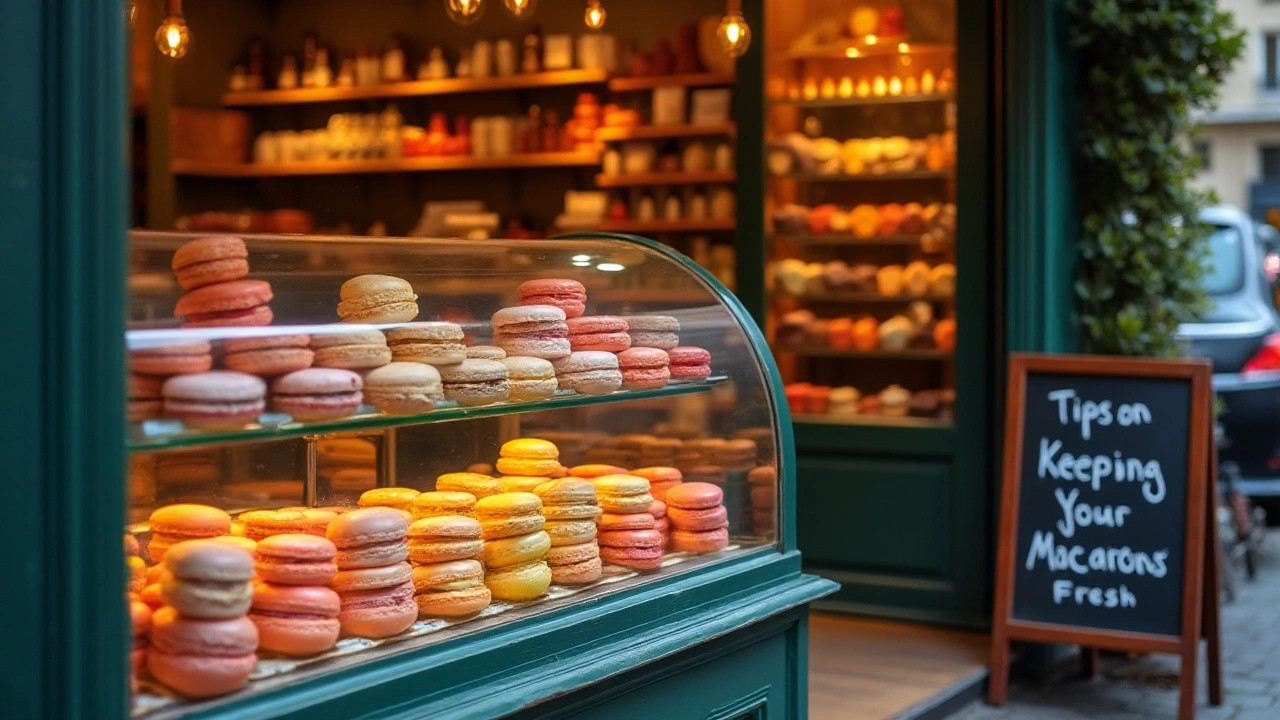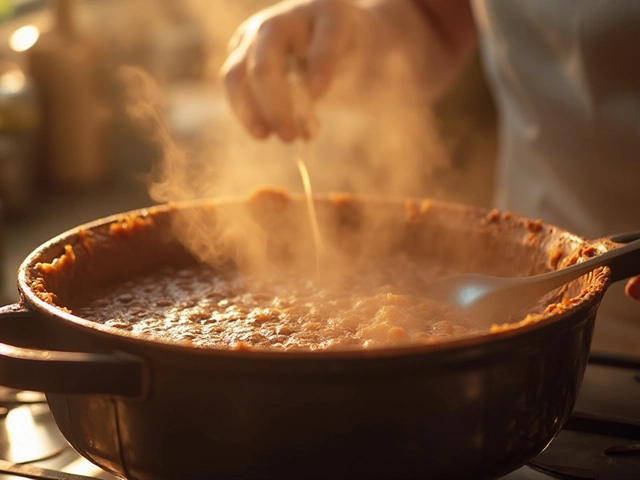
Ah, the delightful macaron! A bite-sized burst of sweetness that can make any day feel fancy. But keeping these little treats fresh as the day they were made is a quest that can puzzle many. Should they stay on the counter or hide away in the fridge? And what about freezing—will that ruin their delicate texture?
The good news is that with a few simple strategies, you can enjoy your macarons at their best whenever you like. We’re diving into everything you need to know about storing these beautiful pastries so they stay just as delightful as when you first laid eyes on them.
- Understanding Macaron Delicacy
- Room Temperature Storage
- Refrigerator Storage Tips
- Freezing Macarons for Longer Keep
- Macaron Containers: What Works Best
- Reviving Stale Macarons
Understanding Macaron Delicacy
Macarons are more than just any sweet treat. Crafted from ground almonds, egg whites, and sugar, these airy confections capture the essence of elegance in each bite. Originating from France, the macaron is not just a dessert; it’s an experience. What makes them special is the delicate balance of crispy shell and chewy interior, achieved through precise baking and a bit of culinary magic. This combination sets them apart and makes the question of proper storage so crucial.
Anyone who's tasted a perfectly made macaron knows that each one is an exquisite showcase of texture and taste. They come in a myriad of colors and flavors, from classic vanilla and chocolate to more daring combinations like matcha and rose. Each bite offers a burst of flavor and a satisfying crunch before melting into a smooth, delicious filling. Macarons are not just confections; they are tiny works of art that demand respect and proper care to maintain their quality.
Because of their inherent fragility, macarons require a gentle touch when it comes to handling and storage. They are prone to absorbing moisture, which can lead to sogginess, and even minor temperature fluctuations can affect their texture. As Ladurée, one of Paris’s most famous macaron houses, suggests: "A macaron should not be underestimated; it's a dessert with nuances." Proper storage involves protecting them from humidity and air exposure, ensuring they remain in their optimal state for enjoyment.
In France, where the macaron first gained its iconic status, it’s common to find these treats stored carefully in airtight containers within controlled environments. This helps maintain the delicate balance between crisp and soft that has made them renowned worldwide. When stored correctly, their flavors blend and deepen, creating a harmony that is often described as heavenly. This balance is essential for creating a macaron that tastes just as good, if not better, than the day it was made.
The macaron's journey from the oven to the table is as fascinating as their flavor. Having started as simple almond biscuits, they’ve evolved into a beloved symbol of culinary sophistication worldwide. This evolution is not just in taste but also in the meticulous methods used in their creation and storage. Expert bakers often advise refraining from consuming them straight from refrigeration, suggesting instead a short return to room temperature to unlock the full spectrum of flavors and textures.
Lastly, while the initial allure of macarons might stem from their vivid appearance and dainty size, the real magic is in transcending the simplicity of the ingredients. Achieving the perfect macaron involves not just whipping up a batter but understanding the science behind its construction. These are not mere cookies; they are a reminder of the elegance that a well-made dessert can bring to the world. Macarons are meant to be savored, not just eaten, and it all begins with understanding how delicate and precious these little edible gems truly are.
Room Temperature Storage
Storing macarons at room temperature can be a great option if you plan to enjoy your treats shortly after purchasing or making them. These delightful confections are often considered best when consumed fresh, as this allows you to fully appreciate their delicate balance between a crisp exterior and a soft, flavorful interior. Typically, macarons can last for about 1 to 3 days at room temperature. It's essential to consider the environment of your storage area; it should be cool and dry, away from direct sunlight and sources of heat, which can cause the macarons to sweat and become soggy.
When keeping macarons at room temperature, one effective method is to store them in an airtight container. This helps maintain their freshness and texture by preventing them from absorbing moisture or odors from the environment. The choice of container is crucial, as it needs to seal well without squashing these delicate treats. A gentle reminder: storing them in a single layer can prevent any potential sticking or damage, maintaining their aesthetic appeal.
Another key factor to consider is the type of filling inside the macaron. Some ingredients, like creams or jellies, might have different requirements for storage as they can spoil faster than butter-based fillings. For example, macarons filled with fresh cream or fruits might not hold as well at room temperature for extended periods and would benefit from refrigeration. Understanding the shelf life of your macaron fillings can help you predict how long they’ll last in different storage conditions.
To illustrate the significance of room temperature storage, the French chef Pierre Hermé, often dubbed the "Picasso of Pastry," emphasizes the importance of respecting the macaron's natural flavors and textures. He once mentioned in an interview,
"Macarons, when freshly made, are a symphony of textures and flavors that come alive only when given the right time and care."This highlights the importance of managing the environment in which your macarons are stored, ensuring you capture the essence of each bite.
If you find yourself needing to prepare macarons for an event, storing them at room temperature for a short duration could help maintain their quality while providing easy access when it's time to plate them. Always ensure the room is climate controlled and avoid any drafts that might create unwanted moisture. This practice helps in retaining the freshness that macarons are known for, allowing them to be savored at their very best.

Refrigerator Storage Tips
Storing macarons in the refrigerator might just be the sweet magic trick you need to keep these delights fresh and fabulous. Unlike cookies that thrive at room temperature, macarons appreciate the cool embrace of a refrigerator. This applies especially if you don’t plan on devouring them all in one scrumptious sitting. The cold environment helps in maintaining their delicate balance between a crisp shell and a chewy interior. It’s important, though, to note that you should refrigerate them in an airtight container. Exposure to air is no friend to these confections as it dries them out, stealing their intended texture and flavor. You can stack them in layers, separating each one with parchment paper. This will prevent them from sticking together, preserving their pristine presentation for the moment you show them off at your next gathering.
On any given day, a macaron spends time in the fridge can be gold. Typically, they last anywhere from three to four days when stored correctly. Interestingly, some argue that a day in the fridge can actually enhance a macaron’s flavor, allowing the ingredients to meld superbly. A popular pastry chef from Paris once noted, "Patience is the secret ingredient in letting the macaron reach its full flavor potential." It’s quite a tasty testament to the fridge being a macaron’s best ally. That said, the key is to not push it beyond its optimal refrigeration life, as prolonged chilling can lead to a chewy disaster. Remember, too, to take them out of the fridge about 20 minutes before consuming. This slight pause allows them to come to room temperature, amplifying their lusciousness with each bite.
While refrigeration is vital for preserving their essence, not all refrigerators are created equal. Temperature control is key. Aim for around 35°F to 40°F; too cold, and the macarons might harden unpleasantly. It's also crucial to store them away from strong-smelling foods. These sweet delights tend to absorb aromas like a sponge, and nobody wants a macaron with a hint of last night’s garlic pasta. Some of the traditional macaron flavors like vanilla or rose can be especially vulnerable to these scent variations. To provide an extra layer of protection, consider wrapping the airtight container in a small towel to shield it from light and odor exposure.
Getting to know how your refrigerator behaves can make a world of difference in keeping macarons fresh for your indulgence. Whether it’s the holiday season or just another Tuesday treat, knowing how to store your macarons properly makes every bit worth it. All these careful efforts highlight the delicate nature of these pastries and amplify the joy they bring once they finally adorn your plate, ready to be the centerpiece of your dessert spread.
Freezing Macarons for Longer Keep
Freezing is a great way to preserve these delicate French cookies when you have more than you can munch through in a few days. The key to successfully freezing macarons lies in proper preparation and storage methods. Macarons are not just about flavor; they are about texture too, the delicate interplay of crispy shell and soft interior is what makes them truly irresistible. To maintain this balance, it's important to cool them completely after baking before considering freezing. A properly prepared macaron will have a higher chance of surviving the freezing process without losing its unique qualities.
Once they are cool, begin by laying the macarons on a baking sheet in a single layer. This prevents them from sticking together and allows air to circulate around each cookie. Afterward, place the baking sheet in the freezer for about an hour until they are firm to the touch. While this may seem like an extra step, it makes a big difference in ensuring that the delicate complexions of these pastries remain intact when stored over the long haul.
After the initial freeze, it’s time to pack them for long-term preservation. Gently transfer the macarons into airtight containers. Here, a container with a snug lid works best to prevent moisture from seeping in or any freezer odors affecting their flavor. It’s advisable to layer them with parchment paper to maintain the structural integrity of each macaron. In a casual yet thoughtful manner, refrigerator storage techniques also apply here; protecting against any moisture contact is vital.
For macaron enthusiasts maintaining their treats for special occasions, note that frozen macarons can last for up to three months. When you’re ready to enjoy, remove them from the freezer and leave them in the fridge to thaw overnight for best results. If you’re in a rush, leaving them out at room temperature for about 20 minutes can also do the trick, but slower thawing under cool conditions best preserves that desired chewiness.
"Freezing macarons properly can keep them fresh and flavorful, ready to delight at any moment you choose," noted renowned pastry chef Christophe Adams.
It is equally important to know the signs of freezer burn and how to avoid it. This unsightly occurrence can happen if macarons aren't adequately protected from the cold air of the freezer. Crispness becomes compromised and flavors dull. To prevent it, always ensure no air can circulate within the container, possibly using an extra layer of plastic wrap before sealing. Remember, what your macaron needs most when frozen is stability in its environment, guarding against sudden temperature changes that can lead to textural shifts. With these techniques, you can keep your delightful macaron storage efficient and your taste buds always indulged.

Macaron Containers: What Works Best
When it comes to keeping those delightful pastel-colored treats fresh, choosing the right container is key. The goal here is not just about storing them, but preserving their delicate balance of textures and vibrant flavors. The ideal storage container for macarons is one that provides an airtight seal to keep external air away while maintaining just enough humidity inside to prevent them from drying out. Many folks might think any simple Tupperware will do, but let's dive a bit deeper.
First off, consider a container with a snug-fitting lid. Glass containers with locking lids can work wonders because they offer a clear view while sealing the environment. These are especially handy for homemade batches where presentation is part of the joy. However, if portable solutions are needed, lightweight plastic containers with airtight seals are excellent. They're easier to transport and do an admirable job of preventing moisture from seeping in and ruining the treat's crunchy shell.
Next, let's discuss the arrangement inside the container. It’s best to lay your macarons in a single layer to prevent them from crushing each other. A good trick is to use parchment paper between layers if stacking is inevitable, but avoid piling them too high. This helps in cushioning against movement especially if they need to be transported. “The secret to storing macarons without losing that perfect chewiness? Keep them snug and straight,” says noted pastry chef Philip Tromp.
For those planning to freeze their macarons, the container takes on a bit more importance. A well-sealed, freezer-safe container is essential; vacuum sealing can further extend their preservation by weeks. Make sure to label your batch with the date it was frozen to keep track of how long they've been stored. Don’t forget that before serving, macarons need to come to room temperature gradually. This requires removing them from the freezer and allowing them to thaw in their packaging to prevent any condensation from marring that glorious surface.
Many bakeries use professional-grade clamshell boxes designed specifically for storing macarons. These boxes align the macarons perfectly with separators, ensuring none of them are touching. While it might not be a necessity for the home baker, knowing these boxes exist might inspire one to mimic the idea using sheets of soft foam or thick paper.
Reviving Stale Macarons
Every macaron lover knows the horror of biting into a once-perfect treat, only to discover its chewy center has turned disappointingly hard. But before you banish those once-perfect pastries, there's hope. Reviving stale macarons isn't as daunting as it may seem, and with patience and a few kitchen hacks, you can bring back their irresistible texture and taste.
One surprising method to revive stale macarons involves a bit of clever steaming. Placing the macarons in an airtight container with a damp paper towel for about 24 hours can work wonders. The moisture from the towel is transferred to the macarons, softening them without soaking them. But be cautious: you don't want a too-wet paper towel, as excessive moisture can make the macarons mushy.
If they're just slightly stale, a quick dip in warm milk or water can also help soften them. Just lightly dip one end and then the other, allowing them to absorb a bit of moisture. Doing this sparingly brings back some of the original bounce without making them soggy. The key is the gentle touch - too much moisture will cause more harm than good.
Another inventive strategy involves temporary freezing. It's counterintuitive, but placing them in a freezer for a few hours and letting them thaw might redistribute the internal moisture perfectly, restoring the soft center. Freeze them in an airtight container to avoid freezer burn, and allow them to thaw at room temperature slowly.
A warm oven can also be an ally when trying to revive those cookies, but this technique needs a careful hand. Preheat your oven to a very low temperature—around 140 degrees Fahrenheit—and place the macarons inside for about five minutes. This warmth can coax some life back into the shell, ensuring it stays crispy yet gentle on the tooth.
As macaron expert Pierre Hermé once said,
"The secret to a perfect macaron is understanding its life cycle and responding to its needs before the charm dissolves."So, treat your macarons with the care of a confection craftsman, and they'll continue to delight and captivate.
Macaron preservation gets even more creative when you engage your culinary senses. Consider pairing slightly stale macarons with ice cream or topping them on a sweet dessert. The contrast can be enticing, and the moisture from the dish can help mask any lingering toughness. So, even if your revival attempts don’t bring them back to perfect condition, you can still enjoy their flavor in inventive ways, ensuring that no macaron goes to waste.




